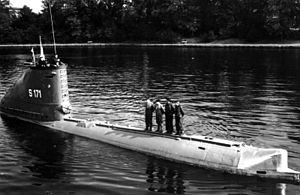German submarine U-2337
 Postwar photo of Hecht (S 171), (former Type XXIII submarine U-2367). A sister ship of U-2337 (This picture of Hecht does not reflect its wartime configuration as it was rebuilt Postwar).
| |
| History | |
|---|---|
| Name | U-2337 |
| Ordered | 20 September 1943 |
| Builder | Deutsche Werft, Hamburg |
| Yard number | 491 |
| Laid down | 2 August 1944 |
| Launched | 15 September 1944 |
| Commissioned | 4 October 1944 |
| Fate |
|
| General characteristics | |
| Class and type | Type XXIII submarine |
| Displacement | |
| Length | |
| Beam |
|
| Draught | 3.66 m (12 ft) |
| Installed power |
|
| Propulsion |
|
| Speed |
|
| Range |
|
| Test depth | 180 m (590 ft) |
| Complement | 14–18 |
| Armament |
|
| Service record | |
| Part of: |
|
| Identification codes: | M 44 676 |
| Commanders: |
|
| Operations: | None |
| Victories: | None |
German submarine U-2337 was a Type XXIII U-boat of Nazi Germany's Kriegsmarine during World War II. She was ordered on 20 September 1943, and was laid down on 2 August 1944 at Deutsche Werft, Hamburg, as yard number 491. She was launched on 15 September 1944 and commissioned under the command of Oberleutnant zur See Günter Behnisch on 4 October 1944.[2][3]
Design
[edit]Like all Type XXIII U-boats, U-2337 had a displacement of 234 tonnes (230 long tons) when at the surface and 258 tonnes (254 long tons) while submerged. She had a total length of 34.68 m (113 ft 9 in) (o/a), a beam width of 3.02 m (9 ft 11 in) (o/a), and a draught depth of3.66 m (12 ft). The submarine was powered by one MWM six-cylinder RS134S diesel engine providing 575–630 metric horsepower (423–463 kilowatts; 567–621 shaft horsepower), one AEG GU4463-8 double-acting electric motor electric motor providing 580 PS (430 kW; 570 shp), and one BBC silent running CCR188 electric motor providing 35 PS (26 kW; 35 shp).[4]
The submarine had a maximum surface speed of 9.7 knots (18.0 km/h; 11.2 mph) and a submerged speed of 12.5 knots (23.2 km/h; 14.4 mph). When submerged, the boat could operate at 4 knots (7.4 km/h; 4.6 mph) for 194 nautical miles (359 km; 223 mi); when surfaced, she could travel 2,600 nautical miles (4,800 km; 3,000 mi) at 8 knots (15 km/h; 9.2 mph). U-2337 was fitted with two 53.3 cm (21 in) torpedo tubes in the bow. She could carry two preloaded torpedoes. The complement was 14 – 18 men.[4] This class of U-boat did not carry a deck gun.[2]
Service history
[edit]On 9 May 1945, U-2337 surrendered at Kristiansand, Norway. She was later transferred to Loch Ryan, Scotland on 29 May 1945. Of the 156 U-boats that eventually surrendered to the Allied forces at the end of the war, U-2337 was one of 116 selected to take part in Operation Deadlight. U-2337 was towed out to be sank on 28 November 1945, by gunfire from the British destroyer HMS Onslow and the Polish destroyer ORP Piorun.[2]
The wreck now lies at 56°10′N 10°05′W / 56.167°N 10.083°W.[2]
See also
[edit]References
[edit]- ^ Helgason, Guðmundur. "Günter Behnisch". Uboat.net. Retrieved 28 April 2016.
- ^ a b c d Helgason, Guðmundur. "U-2337". Uboat.net. Retrieved 28 April 2016.
- ^ Busch & Röll 1999, p. 29.
- ^ a b Gröner 1991, p. 89.
Bibliography
[edit]- Busch, Rainer; Röll, Hans-Joachim (1999). German U-boat commanders of World War II : a biographical dictionary. Translated by Brooks, Geoffrey. London, Annapolis, Md: Greenhill Books, Naval Institute Press. ISBN 1-55750-186-6.
- Gröner, Erich; Jung, Dieter; Maass, Martin (1991). U-boats and Mine Warfare Vessels. German Warships 1815–1945. Vol. 2. Translated by Thomas, Keith; Magowan, Rachel. London: Conway Maritime Press. ISBN 0-85177-593-4.
- Williamson, Gordon (2005). Wolf Pack: The Story of the U-boat in World War II. Osprey. ISBN 1841768723.
External links
[edit]- Helgason, Guðmundur. "U-2337". Uboat.net. Retrieved 28 April 2016.
Text is available under the CC BY-SA 4.0 license; additional terms may apply.
Images, videos and audio are available under their respective licenses.
